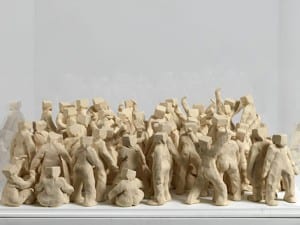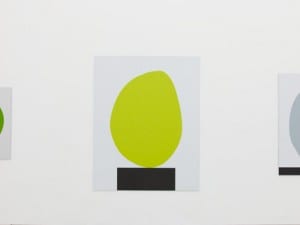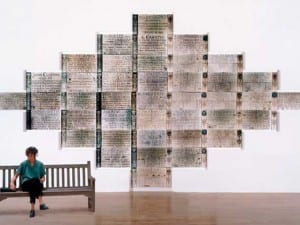Since 2005, Tom Trevor has been the Director of Arnolfini, Bristol’s innovative interdisciplinary art space. Having worked as an artist, musician, television producer, lecturer and independent curator, Trevor is well versed in bringing different art forms together. www.arnolfini.org.uk
What does your programme hold for April/May? Is there always an overarching theme between the disciplines?
Recently we have been developing the programme around broad themes. Our current season, Lingua Franca, looks at the power thresholds that exist within language. For example, if you think about translation, or even pronunciation, and all those different territories defined through language. We’ve just opened an exhibition as part of this by Imogen Stidworthy who works with people who have lost the power of speech, often through accidents, and have had to re-learn how to talk. In the summer, we have a big one-person show by the LA-based artist, Kerry Tribe, and we’ve commissioned a major new work from her, working with Modern Art Oxford and Camden Arts Centre.
How would you define the Arnolfini experience?
It’s about experimentation. We’re always going to be edgy rather than mainstream. We’ve just come out of our Artist / Activist season that’s been very much about participation and collaborative projects, so that has been very intense, focusing on dialogue and co-generation of new work. I guess this next season is going back to more of an observer/critic role for audiences, but there are many different activities alongside it that people can get actively involved in.
What is it that makes this interdisciplinary format so important?
Arnolfini has always been a mixed art centre, perhaps primarily known for the visual arts, but that crossing over between art forms is what produces risky, new experimental work. We’re also well known for our live art programme. Film, music, dance, online projects and literature are all part of this particular chemistry. It’s a real spectrum of the arts. I suppose you could say that visual arts have tended to be more towards the introverted end of the spectrum, which is part of its engine, its critical rigour. It’s good to have a mix of different attitudes bumping up against each other.
Could you tell me a bit about the forthcoming Otto Zitko & Louise Bourgeois exhibition Me, Myself and I?
It’s Otto’s first show in the UK, but he has worked in museums across the world. He makes vast abstract, free-drawing interventions and, at Arnolfini, he’s going to be scribbling across all of our interior walls over three floors for three weeks. Contrasting with that is Louise Bourgeois’ latest drawings, as well as work from the 1940s. She’s now in her 99th year. What she’s been doing recently is a series called Je T’aime. She describes these drawings as being about relationships and the emotional, psychological boundaries between people, whereas Otto’s work is a kind of omnipotent projection of self.
You have Electric Hotel coming up; how was it brought to life through the combination of sound and dance?
We’re collaborating with Mayfest, which is a really interesting experimental theatre festival in Bristol, and Electric Hotel is going to be the centrepiece. It’s a dance piece that has come out of Sadler’s Wells and effectively you’re seeing into a constructed hotel, with bodies visible behind frosted glass, and listening into their conversations, via headphones. It’s going to be quite a spectacle.
How has the changing economic climate in recent years affected audience’s responses to new works?
I was an artist in London during the last recession, having studied at Goldsmiths in the 1980s, and it was a really productive time. Along with my contemporaries, we were producing shows in warehouses, without any money, but really trying things out. Then the market picked up and seemed to seal all of this experimentation up, packaging it and re-branding it. All through that YBA period, it was as if the market was still feeding off the ideas we’d been developing in the 1980s, but somehow it had been taken over by a commercial imperative. So I think it’s a healthy time for arts now, despite the economic downturn, a time to re-think, review and get some fresh ideas.
Is the “digital age” a good thing for art?
Digital is definitely transforming the landscape, not just as a tool, but creating a different set of relationships. If anything, the thing that’s being left behind is that old passive role of audiences coming into a space, feeling baffled and intimidated – that’s not acceptable anymore, we’ve got to engage people and find new ways of enabling them to get involved. The autumn season, which we have called Old Media, specifically talks about definitions of new media. At the same time, many artists are returning to “old media” such as 16mm film or TV. We’ve been using this term new media for more than 20 years now, so what do we really mean? After all, the new media of today is only the old media of tomorrow.
What are your aims for Arnolfini for the future?
We’ve been through quite a radical shift recently, and it’s our 50th anniversary next year, which is going to be a platform to the next 50 years. Our five strategic priorities are experimentation, interdisciplinarity, interaction, social context and internationalism. Within the microcosm of Bristol, we can explore all of the issues of internationalism and globalisation, as a port city and as a place made up of different communities. It is incredibly rich territory for artists, and the starting point has to be critical dialogue and debate that engages with different audiences. That’s our vision. We like to think of ourselves as a space for ideas.





